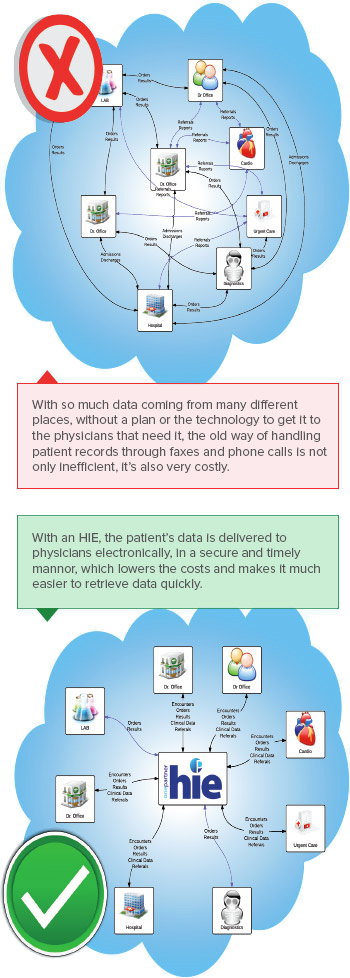What is an HIE?

Up to now, health care has been based upon paper records, face-to-face interaction with one provider at a time, that often resulted in segmented, uncoordinated health care. The exchange of information has been uncoordinated, cumbersome and highly inefficient with silos of valuable information never making their way to those who needed it most - the physician and patient working together to make decisions.
Now, as healthcare becomes more focused on highly efficient care at lower cost with improved health outcomes, a large focus has been placed on the development and exchange of electronic records that provide a more virtual, seamless interaction with providers who are members of a coordinated/collaborative health team, resulting in patient-centric care.
Let's face it, we use technology in our everyday life to make life just a little bit easier. With mini computers in the palm of our hand to tell us everything from the weather forcast to what time the sun will set in Thailand, we've become accustomed to this level of convenience. Why wouldn't we leverage that technology to make navigating the healthcare landscape a little bit easier and more convenient for physicians and patients alike?
A health information exchange (HIE) is the electronic mobilization of health information across healthcare organizations within a region, across the nation, and globally. Basically, it’s the technology that allows for the seamless delivery of health information across care settings to improve care, making it more patient-centric and less administrative and cumbersome in nature.
The foremost goal of an HIE is to make possible the access and retrieval of clinical data so care may be delivered in a safer and more timely manner. Fostering improved patient care by encouraging involvement of multiple clinicians from across the patient care spectrum, continuity of care is greatly improved. No more waiting on faxes to arrive. No more phone calls to multiple providers. All the information available in one community record for the purpose of improved care and efficiency.
HIE Key Benefits
- Improve patient care through real-time connectivity.
- Improve patient and physician satisfaction.
- Cost reduction via improved operational efficiency.
- Ability to quantify and measure outcomes.
- Lays the foundation for medical home, accountable care organizations and success in Pay-for-Value.
HIE Cost Reduction Benefits:
OnePartner HIE can help you reduce these costs.
Are there cost reduction benefits to an HIE? Yes. An internal study by the Sushoo Health Information Exchange found that the current method of exchanging patient’s health information consumes approximately $17,160 in expenses annually, for a single-clinician practice.
With an HIE, practices experience a cost reduction due to:
- Decrease in manual printing, scanning and faxing of documents, including paper and ink costs as well as the maintenance of associated machinery.
- Time reduction in efforts to recover missing patient information, including the physical mailing of patient charts and records, as well as phone communication to verify delivery of traditional communications, referrals and test results.
- Cost reduction due to duplication of tests and diagnostics.